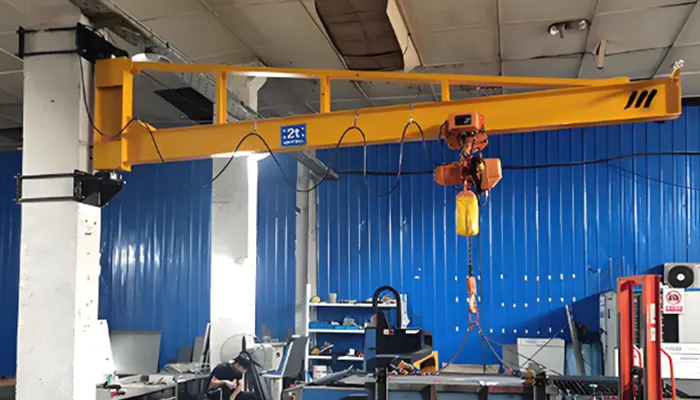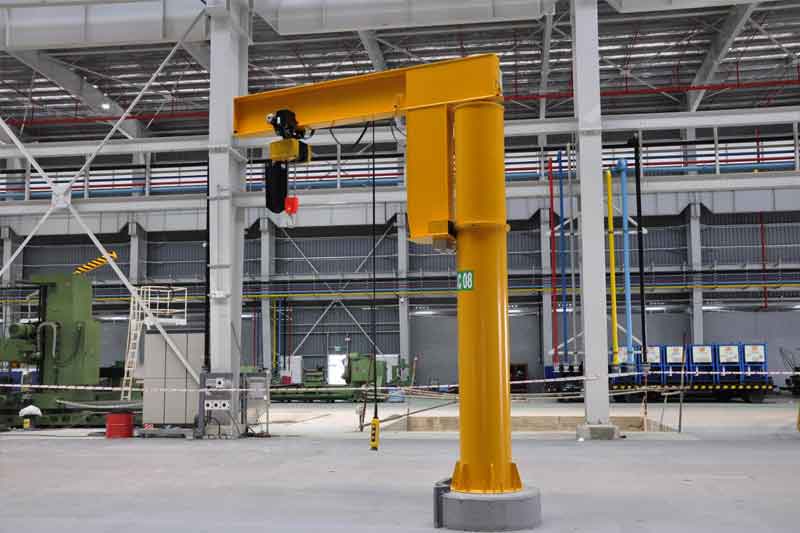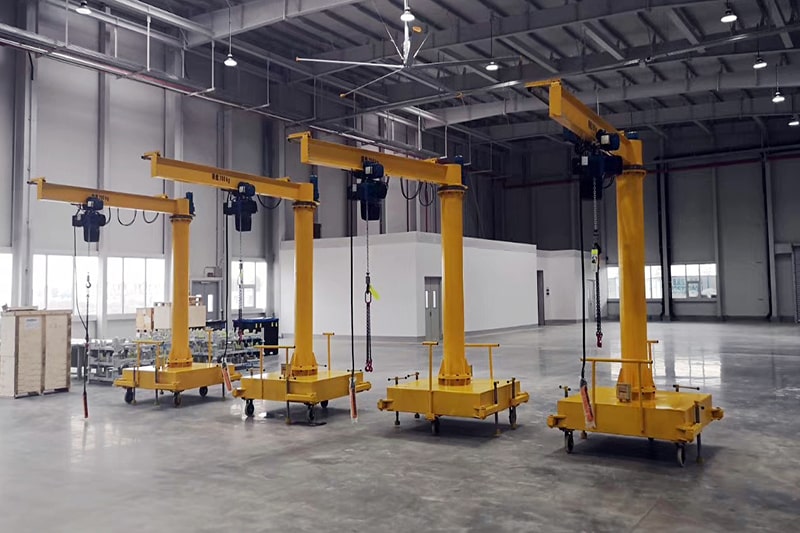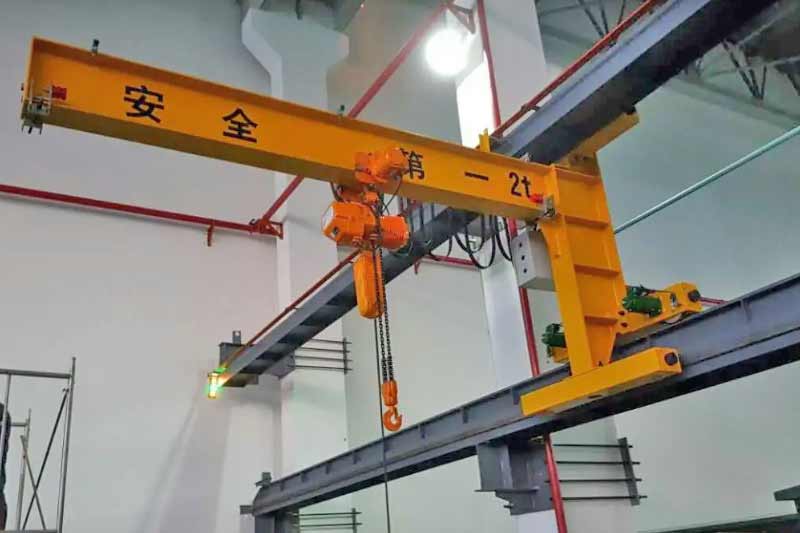Affordable Light Duty Jib Cranes for Efficient Handling for Sale
Light duty jib crane ofr sale. Check our types of affordable light duty jib cranes designed for versatile material handling & maximizing your workspace.
Overview of Light Duty Jib Cranes
Light duty jib cranes are essential tools designed to enhance material handling efficiency in various industrial settings. These cranes consist of a horizontal arm, or jib, mounted on a vertical post, allowing for the lifting and moving of loads within a specific are They are particularly valued for their ability to provide localized lifting solutions, reducing the need for more extensive and expensive equipment.
In industrial environments, efficient material handling is crucial for optimizing workflow and safety. Light duty jib cranes offer a practical and cost-effective solution for moving materials, enabling businesses to streamline operations and improve productivity.
Types of Light Duty Jib Cranes

Wall-Mounted Light Duty Jib Cranes
Wall-mounted jib cranes are affixed directly to walls, maximizing floor space in smaller facilities. They are excellent for tasks where lifting needs are concentrated near walls or storage areas.
Space-Saving Advantages and Applications:
- Ideal for confined spaces where floor-mounted cranes are impractical.
- Commonly used in warehouses, garages, and maintenance areas for moving tools and materials.
- Provides easy access to materials stored in racks or shelves.

Floor-Mounted Light Duty Jib Cranes
Floor-mounted jib cranes are anchored to the ground, providing robust support for lifting operations. These cranes are particularly useful in settings that require stability and high lifting capacities.
Applications in Various Industries:
- Suitable for manufacturing plants where heavy parts need to be moved.
- Often found in shipping and receiving areas for loading and unloading materials.
- Allows for 360-degree rotation, enhancing maneuverability in busy environments.

Portable Light Jib Cranes
Portable jib cranes are designed for mobility, allowing users to move them easily to different locations within a facility. These cranes are typically lighter and can be used for various tasks without the need for permanent installation.
Ideal Scenarios for Portability:
- Great for workshops where tasks vary significantly between jobs.
- Used in outdoor settings for lifting loads in construction or maintenance.
- Enables quick adjustments to meet changing project requirements.
Battery-Powered Light Duty Jib Cranes
Battery-powered jib cranes offer a versatile lifting solution that combines mobility with electric operation. These cranes are equipped with battery systems, enabling efficient lifting without the constraints of power outlets.
Space-Saving Advantages and Applications:
- Flexible Mobility: Easily relocated within the workspace, making them ideal for dynamic environments where tasks vary frequently.
- Ideal for Tight Spaces: Their compact design allows for effective operation in confined areas where traditional cranes may not fit.
- Commonly Used: Often employed in warehouses, workshops, and construction sites for lifting tools and materials, enhancing productivity while reducing manual handling risks.
Wall-Traveling Light Duty Jib Cranes
Wall-traveling light duty jib cranes are mounted on tracks along walls, allowing them to move horizontally while maintaining a compact footprint. This design maximizes workspace and provides flexibility in lifting tasks.
Space-Saving Advantages and Applications:
- Efficient Use of Space: Ideal for facilities with limited floor area, freeing up valuable ground space for other activities.
- Versatile Movement: Allows for easy horizontal movement, making them suitable for long runs of material handling along walls.
- Commonly Used: Frequently found in manufacturing plants, workshops, and maintenance areas, facilitating the lifting and positioning of tools and materials with ease.
Key Features to Consider
Load Capacity
When selecting a light duty jib crane, it’s essential to assess the load capacity required for your operations. Most light duty jib cranes typically handle loads ranging from a few hundred pounds to around 2 tons.
- Typical Weight Limits: Understanding the heaviest loads you’ll need to lift helps guide your selection process.
- Considerations for Selection: Always factor in the nature of the loads (size, shape, and weight distribution) when choosing a crane.
Reach and Height
The reach of a jib crane determines how far it can extend its lifting capabilities. Height is also a critical factor, as it influences how much vertical space is available for lifting.
- Importance of Reach: A longer reach allows for greater flexibility in moving materials within a larger are
- Height Considerations: Ensure that the crane fits within your facility’s height constraints and can accommodate the vertical space needed for lifting.
Materials and Construction
Light duty jib cranes are typically constructed from durable materials like steel or aluminum, affecting their weight, strength, and corrosion resistance.
- Common Materials Used: Steel cranes offer strength and stability, while aluminum cranes are lightweight and corrosion-resistant.
- Choosing Materials: Consider the environmental conditions in which the crane will operate, such as exposure to moisture or chemicals.
Safety Features
Safety is paramount in any lifting operation. Look for essential safety features that enhance the operational safety of light duty jib cranes.
- Essential Safety Components: Overload protection, limit switches, and emergency stop buttons are critical for preventing accidents.
- Regulatory Compliance: Ensure the crane meets industry safety standards and regulations for lifting equipment.
Applications of Light Duty Jib Cranes
Industries Utilizing Jib Cranes
Light duty jib cranes are widely used across various industries, including:
- Manufacturing: For lifting and moving parts in assembly lines.
- Warehousing: For organizing and retrieving inventory efficiently.
- Automotive: In repair shops for handling heavy components.
Common Use Cases
Common applications of light duty jib cranes include:
- Lifting Tools and Equipment: Making it easier to handle and position tools for maintenance and assembly.
- Moving Materials: Streamlining the process of transferring materials from storage to workstations.
- Supporting Assembly Operations: Enhancing workflow in production areas by providing quick access to components.
Benefits of Light Duty Jib Cranes
Improved Efficiency
Light duty jib cranes significantly enhance operational efficiency by simplifying the lifting and moving of materials.
- Streamlining Material Handling Processes: By allowing for quick and easy access to tools and materials, productivity is boosted.
- Reducing Workflow Bottlenecks: Efficient lifting solutions minimize downtime and keep operations flowing smoothly.
Space Optimization
Utilizing wall-mounted or compact designs helps businesses maximize their workspace.
- Utilizing Vertical Space: Jib cranes enable the efficient use of overhead space, freeing up valuable floor are
- Minimizing Floor Usage: Ideal for facilities with limited space, enhancing overall layout efficiency.
Enhanced Safety
By reducing manual lifting and improving ergonomics, light duty jib cranes contribute to a safer working environment.
- Reducing Manual Lifting Injuries: Automation of lifting tasks minimizes strain and injury risks for workers.
- Improved Workplace Safety: Incorporating safety features and protocols enhances overall operational safety.
Selecting the Right Jib Crane
Factors to Consider
When selecting a light duty jib crane, consider the following factors:
- Load Capacity: Assess your lifting needs based on the heaviest materials you’ll be handling.
- Available Space: Evaluate the space for installation, considering height, width, and access requirements.
- Operational Needs: Identify how the crane will be used, including frequency of use and types of materials handled.
Recommendations for Budget-Friendly Models
Here are a few popular budget-friendly light duty jib crane models to consider:
Model A: Fixed Wall-Mounted Jib Crane
- Pros: Affordable, easy installation, ideal for light loads.
- Cons: Limited reach compared to adjustable models.
Model B: Portable Manual Jib Crane
- Pros: Lightweight, easy to move, cost-effective for occasional use.
- Cons: Lower load capacity, requires manual effort.
Model C: Electric Jib Crane
- Pros: High capacity, reduced physical effort, excellent for frequent lifting.
- Cons: Higher initial cost, requires power source.
Maintenance and Safety Considerations
Routine Maintenance Practices
Regular maintenance is essential to ensure the safe and efficient operation of light duty jib cranes.
Importance of Regular Inspections: Routine checks help identify wear and tear, ensuring that cranes function properly and safely.
Maintenance Checklist:
- Inspect for structural integrity and signs of wear.
- Check all safety features, including limit switches and overload protection.
- Perform lubrication of moving parts as needed.
Safety Protocols and Features
Implementing safety protocols is vital for reducing risks associated with crane operations.Essential Safety Features: Look for cranes equipped with safety features such as emergency stop buttons and overload protection.
Best Practices for Safe Operation:
- Train operators on proper usage and safety measures.
- Establish clear communication signals among team members during lifting operations.






